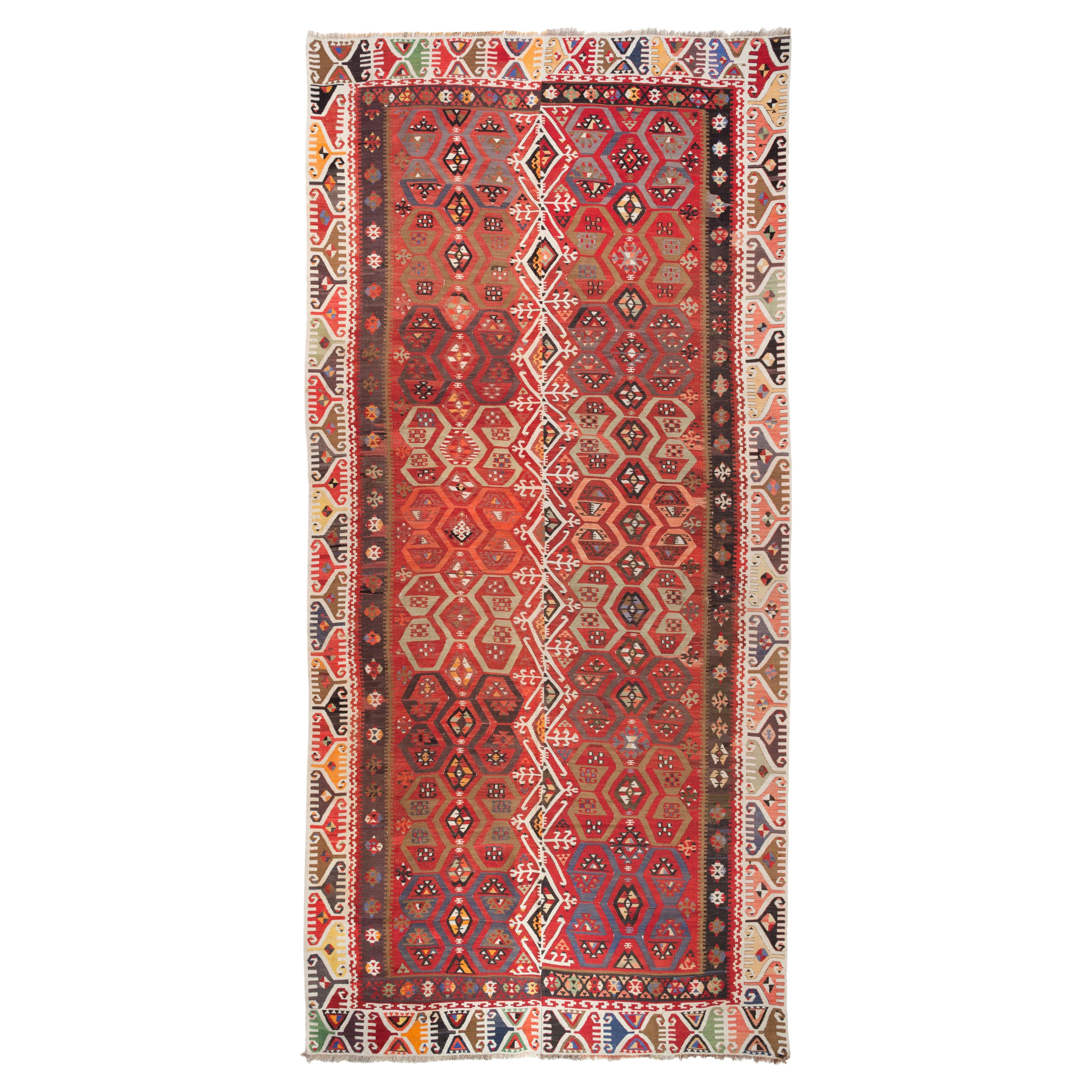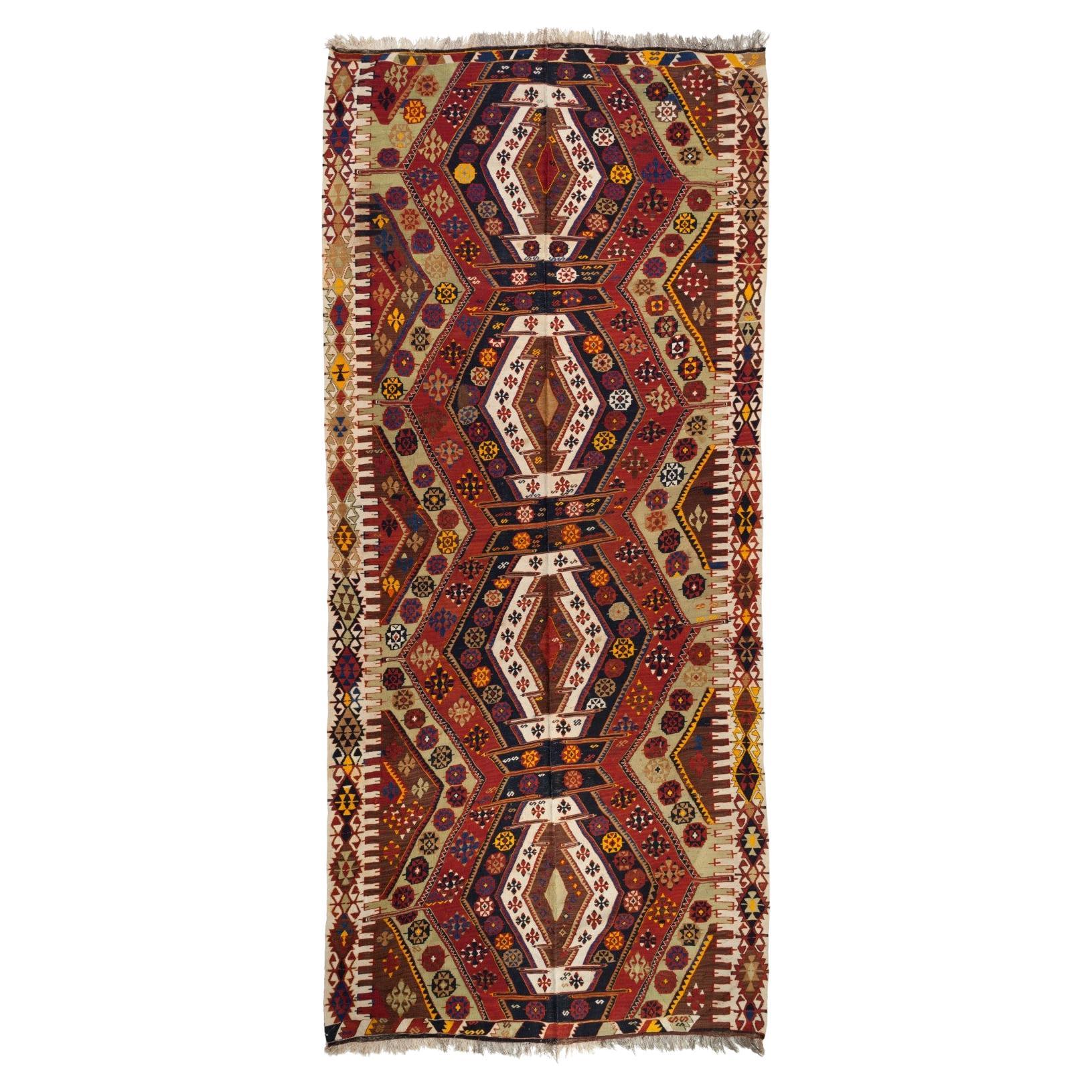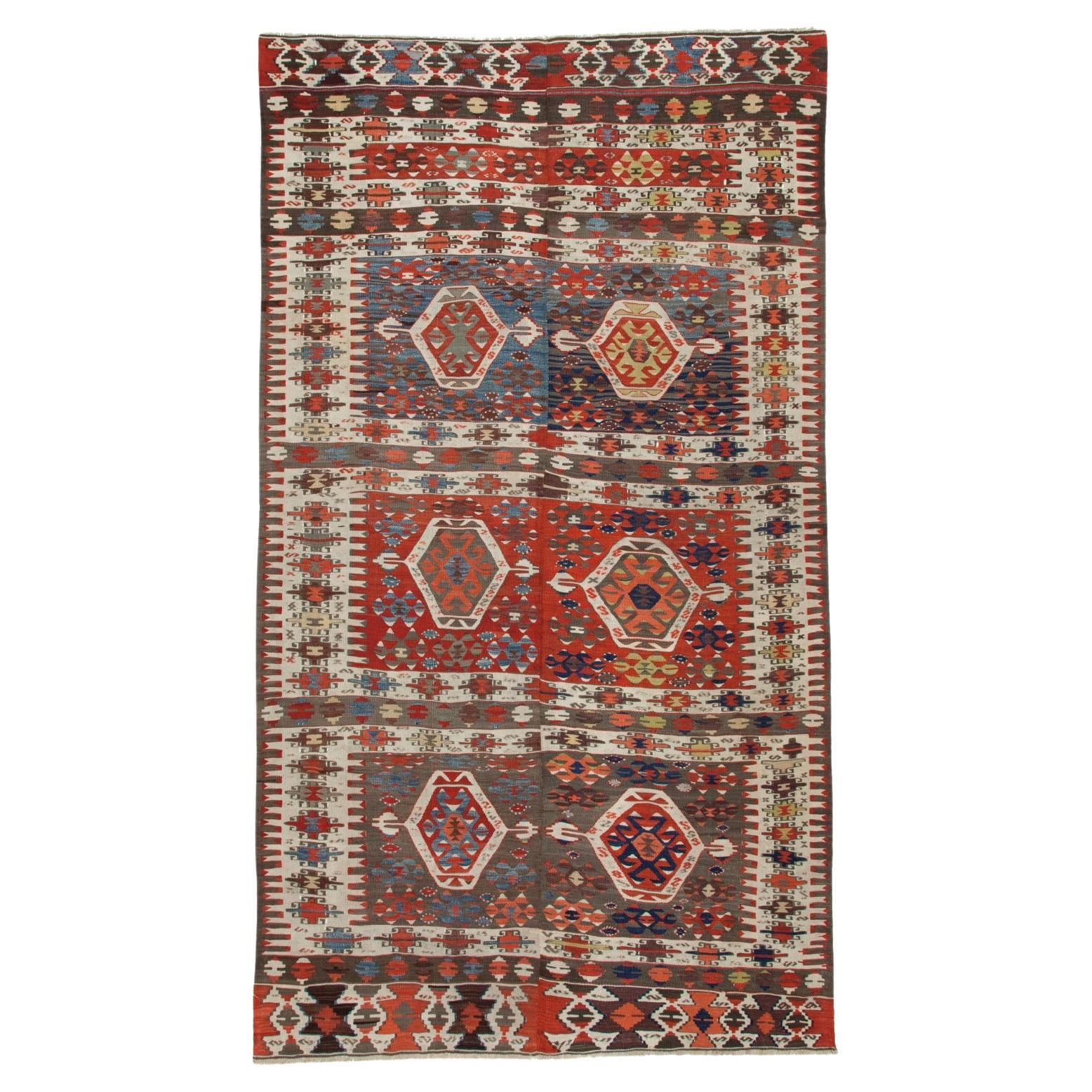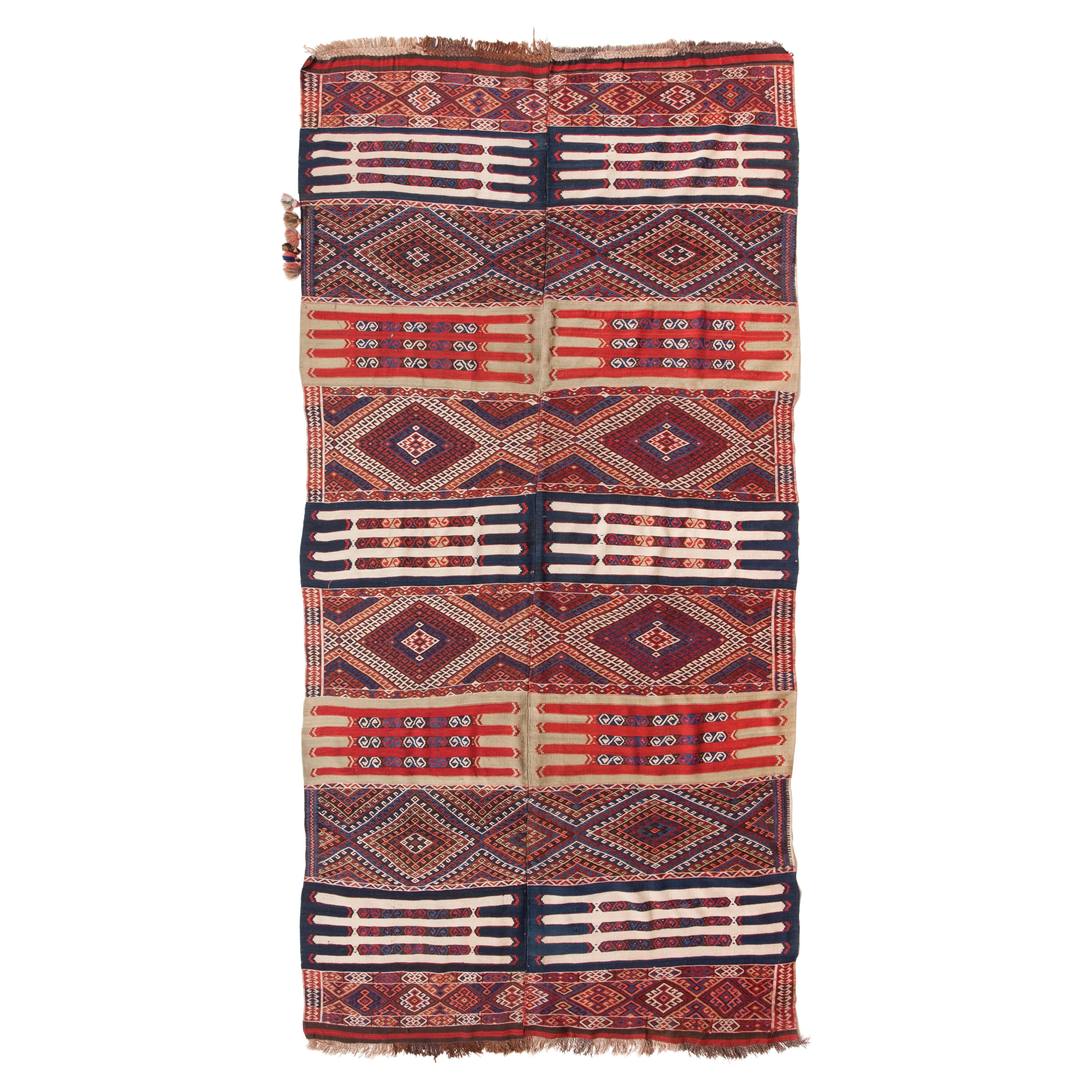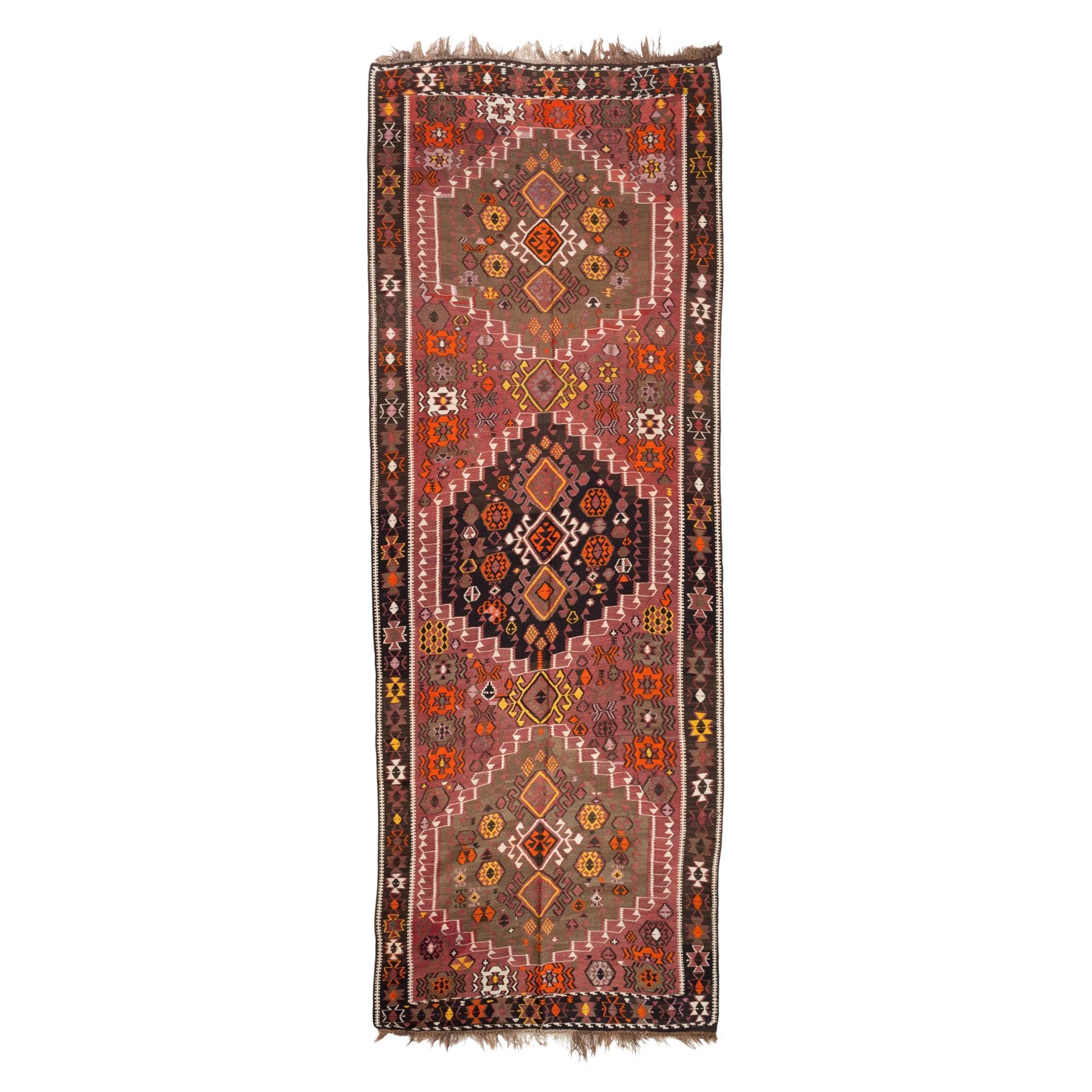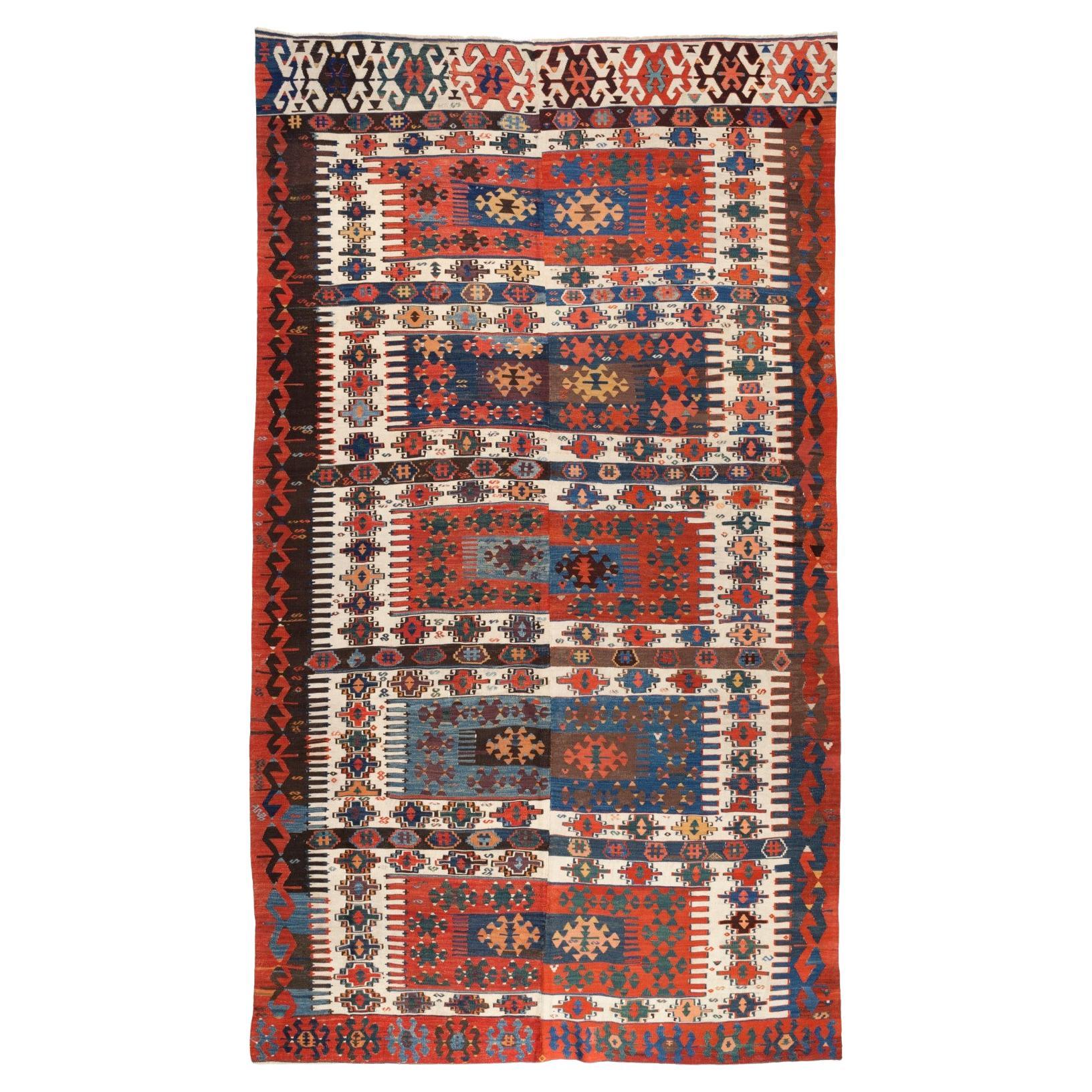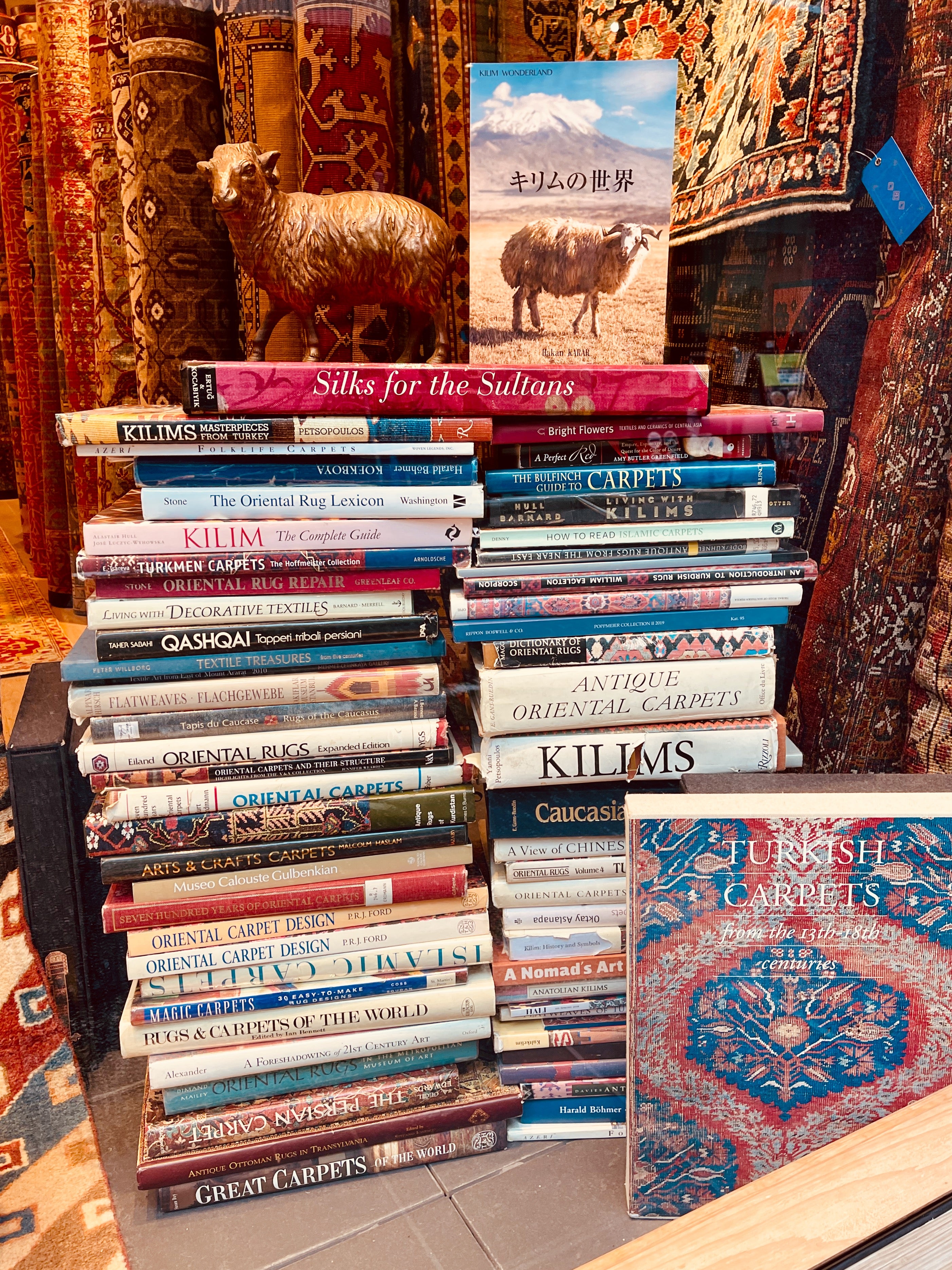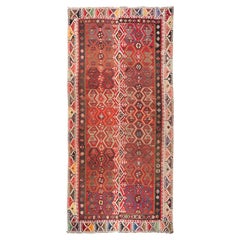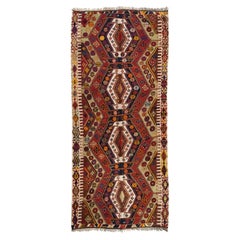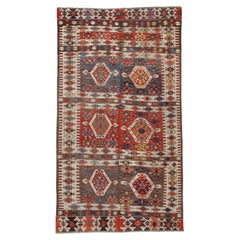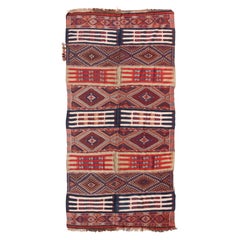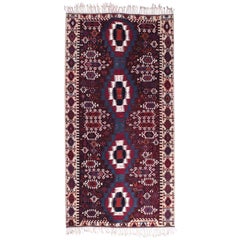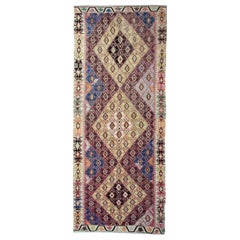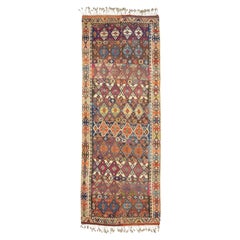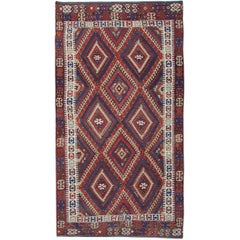Items Similar to Antique Kayseri Kilim Central Anatolian Rug Turkish Natural Carpet
Video Loading
Want more images or videos?
Request additional images or videos from the seller
1 of 7
Antique Kayseri Kilim Central Anatolian Rug Turkish Natural Carpet
$8,500
£6,449.60
€7,374.55
CA$11,872.20
A$13,200.27
CHF 6,892.45
MX$160,679.38
NOK 87,944.67
SEK 82,399.95
DKK 55,037.59
Shipping
Retrieving quote...The 1stDibs Promise:
Authenticity Guarantee,
Money-Back Guarantee,
24-Hour Cancellation
About the Item
This is a large antique Central Anatolian Kilim from the Kayseri region with a rare and beautiful color composition.
It has a Kayseri-like medallion pattern, but it is characterized by its unique and beautiful use of color. Deep and chic, yet woven side-by-side in contrasting colors, the medallions are pleasing to the eye, complementing each other yet subtly harmonizing. Each of the myriad motifs woven into the medallion is randomly colored, which also helps to harmonize the whole. The moss green and burgundy medallion ground colors add a nobleness, the rosy and deep blue colors add a sense of brilliance, and the white adds a three-dimensional beauty to this kilim. The seams on the left and right are well-matched, and the left and right are well-balanced. A beautiful kilim with oriental decorative beauty.
The earliest recorded occupation of Kayseri dates back to Hellenistic times, and although there is no evidence to date, the town was probably built on an early Hittite site as there are many such settlements close by - Kanesh, the first Hittite capital, was situated north-east of Kayseri, at Kultepe. During the first century AD the town was named Caesarea by the Roman emperor Tiberius, later becoming famous as the birthplace of St Basil the Great who was one of the Church Fathers. From the thirteenth to the fifteenth century there were many changes of rulers, amongst whom were the Egyptian Mamelukes until finally, the Ottomans resumed their initial control. Kayseri was once the capital of Cappadocia, being situated at the foot of Mount Erciyes, one of the two volcanoes (the other being Melendes Dagi, near Nigde) that erupted spreading hot volcanic ash over the region, which then hardened into a porous stone called tuff. Over the passage of time erosion occurred leaving strange mushroom-shaped pedestals known as 'fairy chimneys', or peribaca. The tuff, being soft, was also easily hollowed out from the shelter, and during invasions, the Cappadocians would retreat underground. Christians also found the caverns suitable for their churches, particularly during the Arab invasions of the seventh century. These churches, complete with wall paintings, caves, and other subterranean dwellings, were inhabited by the descendants of the ancient Cappadocians until early this century.
Beyond the valleys of the weird rock formations and caves of the Urgup region, the terrain changes into vast sweeps of open country, which end with the impressive snow-clad peak of Mount Erciyes, on the way to Kayseri. North-east of Kayseri are two Seljuk hans or caravanserais, which have been well restored. Kayseri people are known throughout Turkey as being very slick in business, and many jokes are made about them. The caravanserai in Kayseri is situated next to the bazaar and is now used by many kilim and carpet traders. Within the thick walls there is set a small metal door, behind which is a safe where visitors could leave money and other valuables overnight. Kayseri people still weave kilims, and many are made specifically for the export market. It is also the only region producing silk kilims, which are generally loosely worked in slitweave. Other kilims are made in natural wool colors, such as white, brown, grey, and white, again in slitweave. Many compartment-type kilims are woven featuring a square emblem repeated three or four times down the field, according to length. These kilims generally have two main borders and a plethora of small infill motifs which decorate the rest of the field. Another design format features large central medallions of varying shapes; again most of the field is decorated with small motifs. The borders vary in number, and the colors are of an autumnal palette.
- Dimensions:Width: 70.87 in (180 cm)Length: 151.58 in (385 cm)
- Style:Kilim (In the Style Of)
- Materials and Techniques:
- Place of Origin:
- Period:
- Date of Manufacture:circa 1920s
- Condition:Wear consistent with age and use. Minor losses. Minor structural damages. Minor fading. Fair condition, minor restoration is needed.
- Seller Location:Tokyo, JP
- Reference Number:Seller: 210471stDibs: LU8206233562712
ARARAT RUGS
We know and believe that the geography we come from, our past, and our lifestyle are the most important bond between us to carry the oriental carpet art and culture to the next generations along with our core values in our ongoing growth journey.
We are aware that the way to achieve this goal and carry this priceless art and culture to the future depends on a lot of work with all our people every day while adhering to our core values.
For us, art is meaningful in the sense that it brings together various cultures around the world. It is an honor for us that oriental carpet art and culture have been instrumental in this for centuries and that we are a part of this business.
We are tirelessly keeping an eye on auction house information around the world about carpets. New York's Metropolitan, London's Victoria & Albert Museums, and other famous art museums, as well as small specialized museums that house private collections, and books about oriental carpets to collect information on outstanding carpet designs and patterns from around the world. It's our Self-improving and Self-developing culture.
As Turkish Culture of Hospitality, the Kurdish Culture of Generosity, and as Japanese Culture of Business Punctuality; are the most important values that this multicultural background has taught and bequeathed to us. It is essential and valuable for us that you feel this feeling not only by looking at our oriental carpets but from the moment you contact us.
About the Seller
5.0
Platinum Seller
Premium sellers with a 4.7+ rating and 24-hour response times
Established in 1970
1stDibs seller since 2023
55 sales on 1stDibs
Typical response time: 3 hours
- ShippingRetrieving quote...Shipping from: Tokyo, Japan
- Return Policy
Authenticity Guarantee
In the unlikely event there’s an issue with an item’s authenticity, contact us within 1 year for a full refund. DetailsMoney-Back Guarantee
If your item is not as described, is damaged in transit, or does not arrive, contact us within 7 days for a full refund. Details24-Hour Cancellation
You have a 24-hour grace period in which to reconsider your purchase, with no questions asked.Vetted Professional Sellers
Our world-class sellers must adhere to strict standards for service and quality, maintaining the integrity of our listings.Price-Match Guarantee
If you find that a seller listed the same item for a lower price elsewhere, we’ll match it.Trusted Global Delivery
Our best-in-class carrier network provides specialized shipping options worldwide, including custom delivery.More From This Seller
View AllOld Adana Kilim Southern Anatolian Carpet Turkish Rug Central Anatolian Style
Located in Tokyo, JP
This is a Southern Anatolian made in two halves of old Kilim from the Adana region. It has a rare and beautiful color composition, similar to central Anatolian motifs and design.
Ad...
Category
Mid-20th Century Turkish Kilim Turkish Rugs
Materials
Wool, Natural Fiber
Malatya Kilim Rug Wool Old Vintage Eastern Anatolian Turkish Carpet
Located in Tokyo, JP
This is Eastern Anatolian Old, Vintage Kilim from the Malatya region with a rare and beautiful color composition.
This highly collectible antique kilim has wonderful special colors ...
Category
Mid-20th Century Turkish Kilim Turkish Rugs
Materials
Wool, Natural Fiber
Antique Aydin Kilim Rug Wool Old Vintage Western Anatolian Turkish Carpet
Located in Tokyo, JP
This is Western Anatolian Antique Kilim from the Aydin region with a rare and beautiful color composition.
This highly collectible antique kilim has wonderful special colors and tex...
Category
Early 20th Century Turkish Kilim Turkish Rugs
Materials
Wool, Natural Fiber
Antique Malatya Kilim South Eastern Anatolian Rug Turkish Carpet
Located in Tokyo, JP
This is a Southern Anatolian Antique Kilim from the Malatya region with a rare and beautiful color composition.
This kilim is listed in the book; Kilims Flat-woven Tapestry Rugs, Yanni Petsopoulos, 1979 Rizzoli New York, plate nr. 241.
The brocaded bands cross the entire width of the field forming panels contained within very narrow borders. Their decoration consists of a series of alternating large and small concentric hooked lozenges.
Malatya is a town built on one main street that continues for several miles. It is situated in the Tohmasuyu River basin which is encircled by the high peaks of the eastern Taurus Mountains. This is a fertile agricultural region, particularly for apricots, and has been a prolific weaving area for many years. The modern town was established in 1838; old Malatya, which is close by, was once an important city in Armenia Minor. In Roman times it was important as a garrison town on the eastern frontier, and the settlement came under Ottoman rule in the early fifteenth century. Considering the number of kilims woven in this region there is a surprising lack of diversity in design, especially in the larger kilims; this is possibly a direct result of the Kurdish tribal tradition of weaving only one type of design. Small prayer rugs...
Category
Early 20th Century Turkish Kilim Turkish Rugs
Materials
Natural Fiber, Wool
Vintage Old Kars Kilim Eastern Turkey Anatolian Rug Turkish Wool Carpet
Located in Tokyo, JP
This is an old vintage kilim from the Kars region in northeastern Anatolia.
This old kilim has a wonderful chic color scheme and a mature softness. If you look at the precise beauty...
Category
Mid-20th Century Turkish Kilim Turkish Rugs
Materials
Wool, Natural Fiber
$2,148 Sale Price
20% Off
Free Shipping
Antique Aydin Kilim Rug Wool Old Vintage Western Anatolian Turkish Carpet
Located in Tokyo, JP
This is Western Anatolian Antique Kilim from the Aydin region with a rare and beautiful color composition.
This highly collectible antique kilim has wonderful special colors and tex...
Category
Early 20th Century Turkish Kilim Turkish Rugs
Materials
Wool, Natural Fiber
You May Also Like
Antique Central Anatolian Kilim Rug
Located in New York, NY
Antique Central Anatolian Kilim rug. A great example of Anatolian Kilim rug weaving from the 19th century when tribal women wove such pieces as...
Category
Antique Late 19th Century Turkish Kilim Turkish Rugs
Materials
Wool
Antique Rug, Handmade Carpet Oriental Rug Turkish Kilim Runner
Located in Wembley, GB
This handmade carpet colorful rug is a Turkish carpet rug has woven by very skilled weavers in Turkey, who used the highest quality wool and cotton. The flat-weave rug has a light or...
Category
Antique 1880s Turkish Kilim Turkish Rugs
Materials
Wool, Cotton, Organic Material
$5,923 Sale Price
20% Off
Turkish Kilim Rug Vibrant Design
Located in Ferrara, IT
This magnificent Turkish Anatolian Kilim rug, measuring 450 x 165 cm, is a breathtaking example of traditional craftsmanship and vibrant design. Every detail of this handwoven master...
Category
Antique 19th Century Turkish Kilim Turkish Rugs
Materials
Wool
Antique Rugs, Anatolian Turkish Kilim Rugs, Turkish Carpet from Anatolia
Located in Wembley, GB
This Red Rug is a Turkish carpet rug has woven by very skilled weavers in Turkey, who used the highest quality wool and cotton. The flat-weave rug has dark & light red, ivory, blue, ...
Category
1990s Turkish Kilim Turkish Rugs
Materials
Wool, Cotton, Organic Material
Turkish Rugs, Antique Rugs Kilims from Konya, Handmade Carpet Kilim Rug
Located in Wembley, GB
These oriental rugs are from Konya, which is located in the heart of Turkey. The workshop kilim rugs of Konya are mostly known for their distinctive geometric designs. These patterne...
Category
Antique 1890s Turkish Kilim Turkish Rugs
Materials
Wool, Cotton, Organic Material
Antique Rug, Anatolian Handmade Carpet Runner, Oriental Rug Turkish Kilim Runner
Located in Wembley, GB
This handmade carpet colourful Rug is a Turkish carpet rug has woven by very skilled weavers in Turkey, who used the highest quality wool and cotton. The flat-weave rug has a light o...
Category
Antique 1880s Turkish Kilim Turkish Rugs
Materials
Wool, Cotton, Organic Material
$5,342 Sale Price
20% Off
More Ways To Browse
Used Harden
Roman Medallion
Antique Fairy
Roman Capital
Oriental Door
Large Square Ottoman
Harden Bedroom
Burgundy Ottoman
Antique Egyptian Doors
Oriental Pedestal
Ottoman Formations
Antique Chimney Sweep
Crystal Stoppers
Crystal Vase With Silver
Fabric Recliner
German Collector Plate
Mahogany Ball And Claw
Oak Veneer Coffee Table
